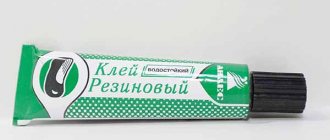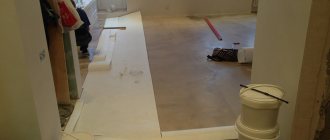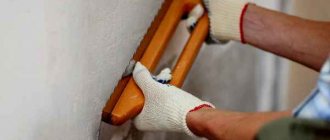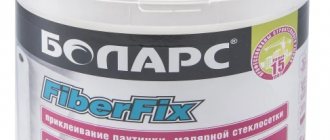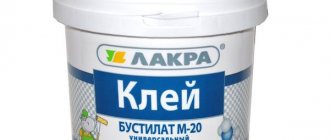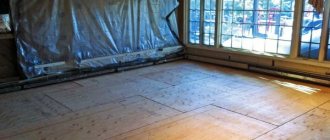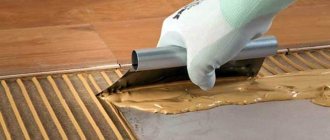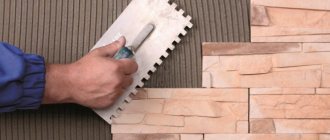Do I need to glue linoleum?
Installation can be carried out without additional fixation or with double-sided tape. These methods are suitable for installing a large-area solid canvas. If the coating consists of several stripes, it is better to apply it with glue. Otherwise, bubbles may appear on the linoleum, and the edge will protrude upward.
Glue improves the adhesion of linoleum to the base, which extends its service life, minimizing the likelihood of water getting under the coating and the development of mold and mildew.
Without glue, you cannot lay canvases in the kitchen, bathroom and other rooms with high humidity. It is also impossible to do without mixtures where large, frequently moved furniture will be used.
Instructions for use
To obtain a high-quality result, you need to study the rules for working with the composition in advance. After all, many products are distinguished by their speed of setting. For successful gluing, follow these steps:
- You should start with surface preparation. The old coating is removed from it, degreased, and cleaned of all types of contaminants. Application occurs on a dry surface, if it is super smooth, it is better to sand the surface, this will improve adhesion. If there are large flaws on the product, they are removed by leveling;
- Work must be carried out at temperatures from +7 to +35 degrees Celsius. If the composition was stored at sub-zero temperatures. Before application, the container should stand in a room at room temperature for several hours;
- If the solution tends to set quickly, then this aspect is taken into account when working;
- Upon completion of all preparatory work, the mixture is applied to the surface evenly;
- There is no need to apply layers too thickly, otherwise the products will shift;
- The items are glued together, the excess is removed immediately with a clean cloth.
To obtain a high-quality result, you need to study the rules for working with the composition in advance.
Advantages of laying on glue
- The service life of the coating increases. The service life when laid with glue will increase by 4-6 years.
- Aesthetics improve. Without glue, linoleum will quickly become unusable, cracks and defects will appear.
- The level of safety and operating comfort increases. It is easier and safer to move on a flat, fixed surface. Less chance of falls and injury.
- There is always the possibility of dismantling and reusing linoleum in another room. If the adhesive is properly prepared and the installation technology is followed, the coating can be easily removed without special equipment and consumables.
- Linoleum is protected from water getting under it, which prevents the development of mold.
Price characteristics of individual types of glue
Data on the cost of the most popular formulations are given in the table:
See also: Laying linoleum - step-by-step instructions
| Name | Types of adhesives | Price per 1 kg (rub) | Specific Consumption (g/m2) | Applicability |
| universal Bustilat | boostilate | 49-51 | 80 — 260 | For felt-based coverings |
| Construction PV | Acrylic plate | 43-47 | 500 — 700 | For felt-based coverings |
| Polynomial 101 | Acrylic plate | 78-82 | 300 — 400 | For baseless household and with foam base |
| Homacall 208 | Acrylic plate | 168-172 | 300 — 500 | For all types |
| Homacall 238 | Acrylic plate | 119 — 121 | 250 — 300 | For commercial types |
| Forbo 425 Euroflex Standard | Acrylic plate | 177 — 181 | 420 -480 | For foamed vinyl and PVC |
| Thomsit L240D | Acrylic plate | 148 — 152 | 400 — 450 | For natural linoleums |
| Gumilax | gumilax | 118 — 123 | For natural linoleums | |
| ADESILEX G19 | Reactionary | 499 — 503 | 300 — 400 | For natural and PVC rubber |
Using the data given in the table, it is easy to calculate the need for glue to cover a certain floor space, depending on the type of linoleum chosen.
What to look for when choosing glue
- Glue base. Can be an aqueous solution, acrylic, latex, rubber, cellulose acid. Products based on such bases should be selected for installation in dry, heated buildings. For coating in conditions of high humidity or low temperature, it is better to buy mixtures based on polyurethane or containing epoxy resin.
- Drying time. The installation time and commissioning of the surface to be glued depends on the indicator. Usually the glue dries in 10 minutes. up to 1 hour
- Consumption per 1 m2. Affects installation costs.
- Packing. The mixtures are sold in containers ranging from 0.1 to 20 liters. Small containers are worth buying for linoleum with an area of 1-2 square meters. For large rooms, appropriate packaging is purchased.
- Method of applying the composition. The mixture can flow out through an elongated spout at the end of the tube or it must be applied with a spatula, scooping it from a separate container. Affects the ease of installation and its time.
- Compatible with PVC backing. Rolled material can have a fabric, foam or fleecy base; there are baseless fabrics. The coating can be homogeneous or heterogeneous.
- Type of base. Linoleum can be glued to highly porous substrates or to floors made of poorly absorbent materials.
How to choose glue for linoleum
It is advisable to select adhesive mixtures for fixing linoleum according to the following criteria:
- Type of base surface.
A hygroscopic (absorbent) surface, which includes reinforced concrete panels, cement-sand screeds, polymer-cement fills, and wooden coverings, requires the use of dispersed water-based adhesives. For substrates with a low level of absorption: ceramic tiles, natural stone, dense rocks and similar materials, only reactive compositions are suitable.
- Floor area.
In small rooms, linoleum is usually laid as a whole sheet. The glue is applied in a continuous layer over the entire surface of the base. The best option for this method of fixation is water-based dispersion adhesives.
Floor coverings for large areas, as well as commercial linoleum, are glued in segments in a checkerboard pattern. In addition, particularly strong fastening must be performed at the joints (seams) between the canvases. For this, a reactive two-component adhesive based on epoxy resin or polyurethane is used. The seams are additionally secured by cold or hot welding.
When fixing linoleum coverings in a large area, special attention is paid to the joints
- Type of linoleum.
The adhesive composition is selected according to its main characteristics based on compatibility with the linoleum material. Typically, manufacturers' recommendations are indicated on the packaging. However, it is better to remember the basic rules:
- a linoleum base made of foamed PVC has better adhesion to any type of adhesive than fabric or jute, so for this type of coating you can purchase less expensive adhesive mixtures;
- The consumption of dispersed adhesive for fixing coatings with a felt or jute base is quite high. If this type of linoleum is combined with a hygroscopic base surface, it is advisable to purchase acrylic adhesives with high viscosity. Due to the reduction in consumption, the difference in cost with budget water-based dispersed adhesives will be completely leveled;
- Natural linoleum should be fixed using adhesives with a minimum water content. Otherwise, moisture may be absorbed into the coating and cause it to deform.
What to glue on
The choice of glue depends on the conditions in which they work.
Water-dispersion adhesives
You can glue not only linoleum, but also laminate. Has no toxic odor, dries quickly, and is easy to use. Suitable for gluing PVC to wood, concrete, metal and other substrates.
Reactive polymer mixtures
Upon contact with the surface, a chemical reaction is provoked, as a result of which a reliable and durable seam is formed. The downside is toxicity, flammability, and unpleasant odor.
Reaction adhesives are justified when installing commercial dense linoleum.
Mastic
Best for gluing to concrete screed. Mastic reliably fixes canvases with a fleecy backing. Bitumen mixtures are used to attach fabric-based linoleum. When gluing with rubber mastics, you can simultaneously level out the unevenness of the base by applying the mixture in a thicker layer.
Gluing linoleum to a concrete floor
Concrete foundations include those in which cement was used. They are capable of drawing in and holding liquid materials. If linoleum is laid “for centuries”, this property will come in handy, but if it is necessary to regularly update the coating, this property will be detrimental. Therefore, the following requirements are imposed on compositions for gluing coatings to concrete. They have to:
- allow material to be removed if necessary,
- hold tightly, do not allow the linoleum to move during operation,
- do not destroy the coating or wash out modifying additives from it.
It is best to buy linoleums with fabric insulation, alkyd (glypthal) for concrete floors. If you purchased the flooring without a base, to install it you will have to lay a layer of fiberboard, chipboard, or OSB.
How to properly glue linoleum to concrete? Here are the step-by-step instructions:
- Prepare the base thoroughly - clean it from dust, dirt, stains, dry it, remove the baseboard. If there are cracks more than 2 mm deep, they must be sealed with a building mixture. The temperature during work is not lower than +15 degrees. Leave the purchased material in a warm room for 2 days without rolling out the roll.
- Drill holes for baseboards and door thresholds, if necessary. Trim the fabric around the perimeter. If the linoleum is laid in one piece, the uneven edges will be covered with a plinth. A gap of 0.5 cm should be left between the wall and the canvas.
- Prime the concrete floor with a composition that is suitable for this purpose and does not conflict with the adhesive components. Compatibility is usually indicated on product packaging. Some experts also prime the back of linoleum, but this is not necessary.
- Next, you can begin installing the coating. Bend down half of the linoleum and apply a thin layer of glue using a spatula. When it is indicated that the composition can be applied with a mesh, this is done. This is usually only allowed in small spaces. Then, if indicated in the instructions, wait until the glue dries slightly.
- Press the covering to the floor and smooth it out. To do this, it is best to use a construction roller (“rolling pin”). Expel all air pockets, moving from the center to the edges. Do the same with the second half of the coating. Place the edge under the door frame. Do not walk on the floor for 1-2 days.
In large rooms it is necessary to glue two or more pieces of material. The technology is the same, but glue is not applied to the edges (by 15 cm), the canvases are overlapped by 3 cm. The joint line is cut along two canvases at once, after first drawing an even strip and pressing it with a metal ruler or temporarily securing it with double-sided tape. This work is carried out after the glue has completely dried. Next, bending the edges, they are glued with “cold welding” type compounds. Then press and roll the joint with a rubber roller, remove excess glue. Apply a load and leave for 2 days. Afterwards you can install the threshold.
What glue to use
The main selection criterion is the type of floor on which it will be installed.
For wood floors
Previously, linoleum was nailed to wood with small nails, but this method spoils the appearance of the coating and does not protect it from deformation. It is better to use special adhesives for attaching to a wooden base.
TEX KS Construction
Universal composition of Russian production. Reliably glues to wood with any quality of sanding, on chipboard or fiberboard. It is applied with a spatula and takes a long time to set, so there is enough time to correct the position of the canvases. Before use, the glue is thoroughly mixed. Operating temperature from 0 °C with a maximum air humidity of 80%. 1 kg of product is enough to treat a surface area of 4 square meters. The mixture is stored in original containers for 1 year.
Density – 1.6 kg/l, which allows you to seal cracks in the base. Adheres to any type of wood and stone. Hot-melt adhesive can withstand temperatures up to +400 °C. Packaged in 0.9 and 3 liters. It dries completely after 3 hours, but the surface can be subjected to stress no earlier than after three days.
SINTEX H-44
Cold welding designed for gluing linoleum joints. Produced in Spain. Packaged in 100 ml tubes. The composition is colorless, after application it hardens for at least 30 minutes. After polymerization, a waterproof seam is formed, so it is often used in bathrooms or kitchens. Sintex H-44 glue is used to fix the ends of linoleum sheets, fill small punctures, cuts, and random gaps up to 0.4 cm wide. Seams with a total area of up to 50 square meters are sealed with one tube.
Initial hardening occurs after 2-3 hours, and polymerization occurs after 2 days. Optimal operating t= +20 °C.
Most suitable for canvases with a foam base.
Polynomial 101
- Adhesive for dense, heavy linoleum sheets.
- Based on acrylic dispersion with fillers and rosin modifiers.
- Bonds foam-based linoleum well.
- It has a thick consistency, work with a spatula. Due to the white color, areas not treated with glue are clearly visible.
- After hardening, an elastic seam is formed.
- Reliably fixes the coating even during mechanical impact.
- Must be used for installation on a base with insufficient supports, which bends when walking. Resistance to tearing – 8 kgf/cm. sq.
- It is used for all types of linoleum, has a neutral odor, does not burn, and is packaged in 18 kg containers.
- Product consumption per 1 sq. m. – 0.5 kg.
- Dries in just over half an hour.
Forbo 522 Eurosafe Star Tack
Monocomponent composition based on dispersion. Packaged in plastic buckets of 13, 20 liters. Bonds any polyvinyl chloride coatings and thermal insulation materials. Can be applied to bare wood or painted floors. Hardening time is 30-60 minutes, the user has enough time to correct the position of the canvases.
When the final location of the linoleum is chosen, it needs to be pressed to the floor and rolled on top with a roller. After gluing, you should not walk on the floor for at least an hour.
It is allowed to fix the covering where frequently moved furniture on wheels or casters is used. Remains of glue are removed with water.
The product adheres well to wood, but to glue linoleum sheets onto a rough board, it must first be sanded. The disadvantage is the price.
For concrete
Concrete floors or screeds can be used as a subfloor in private, multi-storey buildings, commercial or administrative buildings.
Such bases strongly absorb moisture, so it is better to use special mixtures.
TYTAN Professional
Polish glue on a water-dispersion basis. Has a pasty consistency. Apply a 1 mm layer with a spatula. Sold in containers with an easy-to-carry handle with a volume of 1, 2, 4, 7 or 14 kg. Has a neutral smell. Due to the light color of the paste on the concrete, uncoated areas are clearly visible. After installation, you must not walk for at least 30 minutes.
You can glue not only simple linoleum, but also homogeneous, heterogeneous bases, dense materials containing fiberglass inside. The glue can withstand high temperatures, so canvases can be placed on it on top of an electric or water heated floor.
The disadvantage is the price and high glue consumption per 1m2. On average, 1 kg is enough for 3.3 square meters.
NORME COLOR PROFI
Composition of Russian production. It is moderately absorbed into the concrete base and, after hardening, does not allow the coating to shift or peel off. Apply evenly over the entire surface with a notched trowel. It can be used at temperatures down to -25°C without affecting adhesion, making it ideal for installation in unheated areas.
The glue is classified as professional, so it is sold only in large containers of 14 liters.
Suitable for commercial, semi-commercial materials. Withstands heavy traffic (offices, hotels, etc.). Linoleum lays without waves and cracks at the joints, and the service life of the coating increases by 40%. The disadvantage is the expense and price.
Homakoll 208
Russian water-based glue with an admixture of resins. Without solvents, has a neutral odor, does not support the flame when the floor catches fire. It securely attaches to horizontal or vertical surfaces, so in addition to linoleum, it can be used to decorate a room with laminate. Sold in containers of 1, 4, 14 liters. In original containers it can be stored in unheated rooms and can withstand up to 5 freezing cycles.
Has an accelerated drying time due to the low liquid content, which evaporates quickly. Walking on linoleum is allowed within 10 minutes after gluing.
The canvases are glued to a foam, fleecy, fabric base. Suitable for self-installation in a house or apartment. Easy to apply and does not shrink after hardening.
For gluing to concrete, up to 500 g per 1 sq. m. is consumed. Does not glue heterogeneous coatings.
CS "Optimist K503"
You can lay linoleum on jute, fabric or felt, mosaic, ceramic tiles. It is made from liquid glass, industrial oil and fillers. The glue is used at temperatures above +5° C, so it is suitable for use in unheated rooms most of the year. The composition is heat-resistant, can withstand temperatures up to +400 °C. Can be used near open flame sources. The price of glue is four times less than foreign analogues.
Non-toxic, without a strong pungent odor, does not spread after polymerization, and dries completely within a day. Maximum seam strength after 72 hours. Per 1 sq. m. it takes 0.5-0.7 liters. Packaged in 18 liters.
Other brands
- "Expert Bustilat". Glues linoleum to plywood sheets, concrete, wood. The best option for linoleum with a jute or felt base. It takes a day to dry.
- PVA is universal. Has a latex base. Glues materials with a felt base to horizontal and vertical bases. When applied completely over 1 sq.m. 0.25 kg of glue is consumed.
- KS is universal. Based on liquid sodium glass. Suitable for gluing ceramic tiles, canvas with a fabric, felt or jute base.
- "Polynomial 105". Acrylic mixture for all types of bases and floor coverings. Dries in 12 hours.
- Thomsit L240D. Glues sheets no more than 2.5 mm thick onto porous substrates. Non-toxic, used in educational and medical institutions.
- Forbo Eurocol Super. Universal mixture of medium viscosity. Suitable for soft surfaces.
- Forbo Erfurt. With antistatic qualities. Blocks stray currents.
- Bostik KS. Safe dispersion composition. Can fix the coating on heated substrates.
- Linocol. Cold welding for connecting linoleum to each other with a thickness of up to 0.4 cm. Convenient to use due to the thin spout on the tube.
- Mapei Ultrabond Eco Contact. Does not contain solvents. Has high adhesion. Can be glued on vertical planes.
- Glue 88 rubber. Universal mixture for sealing joints. Melts the base, but does not corrode it. Available in cans or tubes.
- Axton is universal. Frost-resistant, used for linoleum and carpet. Packaged in 14 kg cans, the main tool is a spatula.
- Kiilto Uki. Eco-friendly high strength adhesive. Has no smell. Glues PVC plates, carpets, materials with a cellular base.
- Titan Wild. Apply to any base and dilute with alcohol when thickening.
- VGT floor-standing "Economy". Glues household linoleum and carpet. Moisture-resistant elastic paint and varnish material that can withstand freezing.
- "Werner Müller". There are several series of adhesives for welding new and old coatings, natural and synthetic substrates. Glue only in a dry room.
- Tarkett. There are compositions for natural materials, for single-layer coatings, and products with disinfecting properties. Adhesives are available for semi-commercial and commercial flooring materials.
Types of adhesive mixtures for linoleum
The brands of linoleum adhesive on the market can be divided into two main categories: reaction and dispersion. They differ significantly in their characteristics, methods of application and cost. Let us consider their main operational parameters in more detail.
Dispersion adhesive mixtures
The dispersion adhesive contains acrylic, latex, chalk as a filler, and cellulose-glycolic acid. This is a water-based, odorless mixture. A weak, unstable specific aroma can last for several hours after the end of pasting. During work, no toxic or carcinogenic substances are released into the air. Recommended for use in residential premises.
The market offers dispersion compositions from various manufacturers in three main categories:
- Bustilat . Used to secure linoleum with a fleecy or felt base. The raw materials used are latex, powdered chalk, carboxymethylcellulose;
Bustilate is a universal composition that can be used to fix most types of linoleum
- Acrylate . Thermoplastic resins are used as adhesives. The composition has a high viscosity and is used for gluing heterogeneous and homogeneous linoleum, as well as coatings based on jute and synthetic fiber. Recommended for use in high traffic areas. The composition ensures high adhesion of the floor covering to hygroscopic substrates.
Acrylic adhesive ensures the strength of fastening linoleum to the hygroscopic base
- Gumilax . The mixture contains latex and rubber. Used for fixing natural types of linoleum, as well as synthetic coverings on felt and fabric bases.
Gumilax - used for fixing household and semi-commercial linoleum
Dispersion adhesive compositions have certain technical limitations. The main disadvantage is high sensitivity to humidity and low temperatures. After freezing, dispersion adhesive loses its basic properties: elasticity decreases, the adhesive layer begins to crumble under mechanical stress. At high humidity, adhesion is significantly reduced, even to the point of peeling off from the base.
Important! Dispersion adhesive compositions are recommended to be used for fixing linoleum in rooms with a temperature not lower than +15ºС and humidity not exceeding 60%.
Reaction adhesives
Reaction adhesive mixtures consist of two components: a base and a hardener. The gluing process is a polymerization reaction of a substance after mixing two main components. Epoxy and polyurethane polymers are used as active substances. The advantages of their use are as follows:
- resistance to high humidity;
- good ductility;
- there is no shrinkage after drying due to the absence of water in the composition.
The price of reaction compositions is significantly higher than dispersion ones. They have a strong chemical odor and, in addition, release significant amounts of volatile flammable substances during the mixing and application process. Therefore, during work, it is necessary to comply with fire safety requirements and ensure good ventilation of the room. All manipulations with such adhesives must be carried out only in personal protective equipment - respirators and gloves.
Two-part epoxy adhesive used to secure commercial heavy-traffic PVC flooring
Reaction adhesives are used for fixing homogeneous linoleum, PVC tiles, and foam-based linoleum. This adhesive composition is not suitable for felt and fabric bases.
Depending on the level of adhesion, reaction compounds are divided into three main groups, which are recommended for use to perform a certain type of work:
- group “A” - used for local fixation of new linoleum on a clean concrete and cement-sand base. As a rule, it is used for the initial sealing of joints, making them almost invisible;
- group “C” - used for attaching linoleum to bases made of wood materials: plywood, chipboard, OSB. It can also be used as a repair composition for re-fastening seams that have come apart as a result of use;
- group “T” - used for processing the joints of polyester-based linoleum sheets. This composition is highly toxic and quite difficult to work with. It is not recommended for use by craftsmen who do not have relevant experience.
Polyurethane compounds are more versatile. They can be used both for fixing linoleum and parquet
Gluing methods
It is possible to lay the coating efficiently if the surface material is taken into account. The base for gluing is carefully prepared.
- Must be durable. Fallen pieces of concrete and peeling wooden boards are removed.
- Dry. On a wet base, high-quality glue adhesion is impossible.
- Smooth. Any difference or unevenness after installation will become even more noticeable.
- Clean. Any debris left on the floor will ruin the appearance of the linoleum.
It is necessary to ensure the correct temperature conditions. The air must warm up to at least +18 °C, and its humidity cannot exceed 70%. If installation is done in winter, it is better to keep the linoleum roll in the house for several days.
If there are creases on the canvas, the rolls are rolled out and laid out at room temperature for at least five days. When the linoleum is leveled, it is adjusted to the size of the room. The excess near the walls is cut off with a knife, leaving a small allowance of up to 1 cm. The installer’s further actions will depend on the type of floor.
On the concrete floor
If there are minor defects on the concrete floor, they are rubbed with a mixture of sand and cement. If there is a significant difference in height, the floor is filled with cement screed. You can start gluing only after it has completely hardened. If there is no time for the screed to dry completely, the floor is leveled with polyurethane-based self-leveling mixtures. A day after leveling the surface, you can begin laying.
It is best to glue linoleum onto a concrete base with mastic.
The canvases are laid on the floor, their edges are bent, the glue is applied in an even layer to the concrete, the material is pressed to the base and carefully smoothed. At the final stage, the joints are sealed.
On a wooden floor
The strength and evenness of the base is checked. If necessary, squeaky floorboards are fixed and height differences are detected with a level. If there is no such need, you can immediately begin installation.
Plywood will help smooth out minor unevenness.
Before gluing to fiberboard sheets, check whether the heads of the nails that secure the boards to the floor protrude from above. The caps should be deeply recessed into the material, and the joints between the plates should be puttied and sanded after the putty has dried.
Linoleum is attached to chipboard and OSB with Bustilate or PVA. The fixation to ordinary plywood is the same as the fixation to a wooden floor.
On old linoleum
You can lay new linoleum on the old one without preparing the base. The old material will provide additional heat and sound insulation. Dispersive substances are suitable for adhesive compositions. They have good adhesion and are applied with a spatula. The thickness of the layer should not exceed 0.2 cm. After applying the mixture, the canvas is pressed tightly to the base and carefully straightened.
You cannot lay a new coating on top of dried out or severely deformed linoleum, since over time it will become unusable.
Advantages and disadvantages of gluing linoleum
Why do professionals prefer to install carpet or linoleum using adhesive? This installation method is ideal for rooms with an area of more than 10-15 square meters, where it is often necessary to place several joining strips. It is necessary to glue it if you need to fasten individual pieces, for example, to change part of a damaged coating.
The advantages of the sticker are:
- Even in a small room, loose linoleum can bubble and become deformed over time. Gluing will increase the contact area of the flooring with the base and prevent waves from occurring.
- The use of special adhesives reduces the risk of pitting from furniture legs. Also, when sofas, wardrobes and beds move across the floor, the risk of the covering moving is significantly reduced.
- Without glue, cracks appear at the joints, and the edge of the linoleum sticks out unsightly, curls, and water gets under it when washing the floor. The use of an adhesive composition eliminates this problem.
- The service life of securely attached decking increases by 20-40%, which is especially true for thin materials that are prone to damage and tearing. The glue helps reduce the incidence of microcracks.
- A tightly glued coating better protects against water leakage in an emergency and prevents mold and mildew from multiplying. If linoleum is laid on a wooden floor, the base material will not rot.
There are disadvantages to this installation technology, but they are few. Economy series products are not very reliable, and high-quality adhesives are not cheap. Therefore, the cost of repairs can increase significantly. Disadvantages also include the following:
- increasing the time for repairing a room by 1-3 days,
- increased labor intensity of work,
- the difficulty of tearing linoleum off the floor (if you need to re-glue it),
- impossibility of reusing the coating - when dismantled, it breaks into pieces.
If you are not an expert in the question of which glue to choose, there is a risk of purchasing a composition that has a negative impact on the environment and is harmful to humans. The chemical ingredients of the glue improve adhesion and other beneficial properties, but have a negative effect on the body.
How to glue the edge
To coat the edges it is better to use Bustilat. It is transparent and will not spoil the appearance of the canvas, even if it accidentally gets on the outside.
The edge of the linoleum is folded back, the base is coated with Bustilat, the sheets are pressed end to end and smoothed out. The load is placed on top. When Bustilat has dried, a threshold strip is attached or a plinth is installed.
The edges of a single-color coating can be fixed with reaction compounds. Cold welding is used to seal the seams. First, masking tape is glued to the joint. A cut is made along the seam into which sealant is carefully poured. After it hardens, the masking tape with the remaining glue is removed from the linoleum.
Advice from professionals
- In living rooms with a small area, to save glue, it is enough to apply it only near the threshold, additionally securing the canvas with a strip.
- In a room of no more than 10 square meters. and without a lot of traffic, you can use double-sided tape.
- When installing yourself, you need to apply the glue gradually, covering small areas. On each of them it is necessary to carefully press the linoleum to the base.
- When laying directly on concrete, without an additional insulating layer, it is better to install an additional heating system or make thermal insulation of the screed from plywood or OSB boards with a layer of waterproofing.
- If there are communications under the linoleum that must remain freely accessible, do not use heavy-duty adhesives. It is better to choose means for temporary fixation. If necessary, the canvas can be easily removed.
Gluing the coating to a wooden floor
The general requirements for a wooden floor are as follows: the base must be clean, dry, and level. If there are gaps between the boards or sheets, they must be puttied. The linoleum roll is left indoors for 2 days at room temperature. To work you need to prepare:
- glue,
- roulette,
- putty knife,
- rubber roller or clamp,
- sharp knife,
- marker.
It is recommended to purchase linoleum strictly according to the size of the room - this will avoid joints and seams. Before gluing, trim around the perimeter, taking into account the architectural features of the room. At the same time, hold the cut part so that the coating does not tear, and place a board under the bottom. Pre-glue double-sided tape to plywood, OSB, and boards at a distance of 40 cm from each wall. This will help prevent the covering from moving when trimming. After a day you can start gluing. Before work, roll up a roll.
The procedure is almost the same as with a concrete base, but has the following features:
- at the edge of the roll, coat the wooden floor with glue - a strip 30 cm wide, while it is advisable to make the layer of uniform thickness, without bumps and grooves,
- apply the material to the smeared area, act precisely, since repeated rolling reduces the quality of gluing,
- move to the unfolded area, remove air from under the linoleum with a flat clamp,
- inspect the surface of the material from different angles to completely eliminate the presence of bubbles,
- cover the entire room with strips of 30-40 cm, rolling out the roll,
- After the composition has hardened, you can glue the joints using cold welding or another method, and then secure the baseboards.

